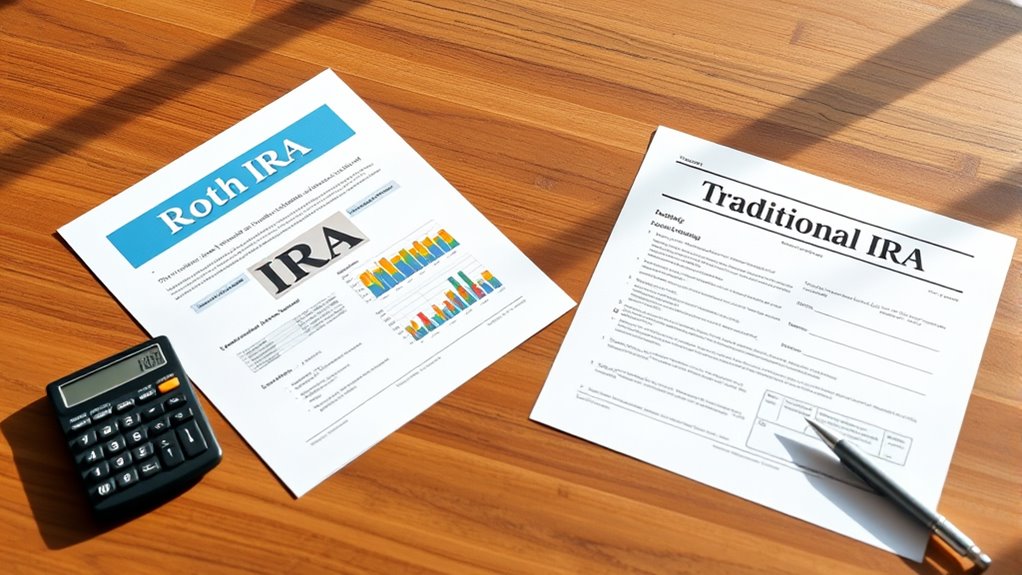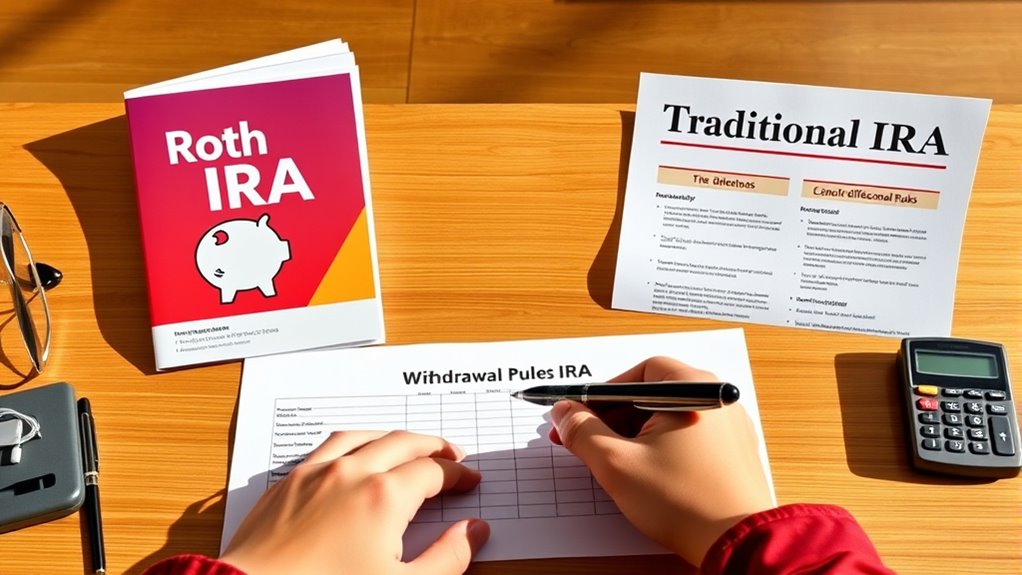A Roth IRA and a traditional IRA differ mainly in tax benefits. With a Roth, you contribute with after-tax dollars, and qualified withdrawals are tax-free, making it ideal if you expect higher future earnings. A traditional IRA lets you contribute pre-tax, giving an immediate tax deduction, but you’ll pay taxes on withdrawals. Your eligibility and tax situation influence which is best. Keep exploring to understand how each option fits your retirement goals.
Key Takeaways
- Traditional IRAs offer immediate tax deductions, with taxes paid upon withdrawal; Roth IRAs are funded with after-tax dollars, with tax-free withdrawals.
- Contribution eligibility for Roth IRAs depends on income limits, while Traditional IRAs have no income restrictions for contributions.
- Early withdrawals from Traditional IRAs may incur penalties and taxes; Roth IRA contributions can be withdrawn anytime without penalties.
- RMDs are required for Traditional IRAs starting at age 73, but Roth IRAs have no mandatory withdrawals during the owner’s lifetime.
- Roth IRAs grow tax-free and are ideal for long-term, high-growth investments; Traditional IRAs provide tax deferral, beneficial for current tax savings.
Key Tax Differences Between Roth and Traditional IRAs

The key tax differences between Roth and Traditional IRAs mainly revolve around when you get the tax benefits. With a Traditional IRA, you typically get an immediate tax deduction on your contributions, lowering your taxable income for that year. However, you’ll pay taxes when you withdraw the money in retirement. Conversely, Roth IRA contributions are made with after-tax dollars, so you don’t get a deduction upfront. Instead, your qualified withdrawals in retirement are tax-free. This fundamental difference impacts your tax planning: Traditional IRAs can reduce your current tax bill, while Roth IRAs offer the advantage of tax-free income later. Your choice depends on whether you prefer immediate savings or tax-free income in retirement.
Income Limits and Eligibility Requirements

Your eligibility to contribute to a Roth IRA depends on your income level, as there are income limits that restrict high earners from making direct contributions. If your modified adjusted gross income (MAGI) exceeds certain thresholds, you may be ineligible to contribute directly to a Roth IRA. For 2024, single filers with a MAGI over $138,000 can’t contribute directly, and those over $153,000 are completely ineligible. For married couples filing jointly, the limit starts at $218,000, with full ineligibility above $228,000. If you earn too much, you might consider a Roth conversion or other strategies. Traditional IRAs don’t have income limits for contributions, but deductions may be phased out based on income and participation in employer-sponsored plans. Understanding income limits can help you plan your retirement strategy effectively.
Contribution Limits and Rules

Once you determine your eligibility to contribute to a Roth IRA, understanding the contribution limits and rules becomes key to maximizing your retirement savings. For 2024, you can contribute up to $6,500 if you’re under 50, or $7,500 if you’re 50 or older, thanks to catch-up contributions. These limits apply across all IRAs you own, so if you have multiple accounts, your total contributions can’t exceed these caps. Your contributions must be made with earned income, and there’s no tax deduction for Roth IRA contributions. Keep in mind, contributions for a given year can be made up until the tax filing deadline (usually April 15 of the following year). Staying within these limits ensures you avoid penalties and keeps your account on track for growth. Additionally, understanding credit score implications can help you maintain access to favorable loan terms and financial products in the future. Monitoring your contribution history can help ensure compliance with IRS rules and optimize your savings strategy. Being aware of contribution limits can also prevent overcontributing, which may lead to penalties. Moreover, reviewing brand reputation and product authenticity, especially for related financial tools or services, can help you make informed decisions to support your savings goals. Staying informed about AI-powered financial tools can further enhance your retirement planning and investment management.
Withdrawal Rules and Penalties

When you withdraw funds from your IRA, there are specific rules and penalties to keep in mind. If you take money out early, you might face penalties, and age-related restrictions could require you to start taking minimum distributions. Understanding these rules helps you avoid costly surprises and plan your withdrawals wisely. Being aware of potential tax implications can further help in making informed decisions about your retirement funds. Additionally, exploring the legacy of great explorers can inspire you to navigate your financial journey with resilience and curiosity. Knowing the laws surrounding alimony can also impact your financial planning during retirement. Incorporating a mindset of abundance can help you approach your retirement planning with confidence and clarity. Moreover, understanding the contrast ratio in projectors emphasizes the importance of visual quality, which can be a useful analogy in assessing your investment options for retirement.
Early Withdrawal Penalties
Early withdrawals from IRAs generally come with penalties that can substantially reduce your savings. If you take money out before reaching the designated age, you’ll face a 10% early withdrawal penalty on the amount withdrawn. This penalty applies to both Roth and traditional IRAs, unless you qualify for an exemption. Common exceptions include using the funds for a first-time home purchase, qualified education expenses, or certain medical emergencies. Keep in mind that, with a traditional IRA, you’ll also owe income tax on the withdrawal, which can increase your tax bill. Roth IRAs allow you to withdraw contributions penalty-free at any time, but earnings may be penalized if taken early. Understanding these penalties helps you avoid unnecessary costs when managing your retirement savings.
Age-Related Restrictions
Age plays a significant role in IRA withdrawal rules and penalties. For traditional IRAs, you must be at least 59½ to withdraw without penalties, or face a 10% early withdrawal penalty. Roth IRAs, on the other hand, allow tax- and penalty-free withdrawals of contributions at any age, but earnings are restricted until age 59½ and the account has been open for five years. Financial management best practices suggest planning withdrawals carefully to optimize your retirement savings. Consider these key points:
- Early withdrawals of earnings before 59½ incur penalties unless exceptions apply
- Contributions can be withdrawn anytime without penalties
- Turning 59½ generally allows penalty-free access to earnings
- Age 73 marks required minimum distribution age for traditional IRAs
- Roth IRAs have no RMDs during your lifetime
Additionally, understanding the age-related restrictions can help you avoid unnecessary penalties and retirement planning maximize your benefits over time. Being aware of the exemption criteria for early withdrawals can also provide additional flexibility when managing your retirement funds. Moreover, staying informed about automated investment options can help you optimize your savings strategy over the long term.
Required Minimum Distributions
Required Minimum Distributions (RMDs) are mandatory withdrawals you must start taking from your traditional IRA once you reach a certain age, ensuring you don’t defer taxes indefinitely. If you don’t withdraw the RMD, you’ll face a hefty penalty of 50% on the amount you should have taken. RMD rules don’t apply to Roth IRAs during your lifetime, but they do for traditional IRAs. Here’s a quick overview:
| Age to Start RMD | Penalty for Not Taking RMD | RMD Calculation Method |
|---|---|---|
| 72+ (or 70½ if born before July 1, 1949) | 50% of the RMD amount not withdrawn | Based on IRS life expectancy tables |
| First RMD Due | Penalty applies if missed | Account balance divided by life expectancy |
| RMD Deadline | December 31 annually | Varies depending on the year |
Additionally, understanding the federal regulations surrounding RMDs can help you plan your withdrawals more effectively, especially since regulatory changes may alter these requirements over time. Staying informed about retirement account rules can prevent costly penalties and ensure compliance with tax laws. Being aware of potential tax law modifications can also impact your withdrawal strategy, helping you optimize your retirement savings. Keeping abreast of tax laws related to retirement accounts ensures compliance and optimized retirement planning.
Required Minimum Distributions (RMDs)

Once you reach the RMD age, you’ll need to start taking minimum withdrawals from your traditional IRA. You’ll calculate these amounts based on your account balance and life expectancy, so understanding the rules is vital. Failing to take your RMDs on time can result in hefty penalties, so staying on top of the schedule is essential. Be aware that state-specific tax laws can influence your overall retirement income and withdrawal strategies. Additionally, considering the varying state tax implications across different states can help optimize your withdrawal plan and manage your tax liabilities effectively.
RMD Age Requirement
Understanding the RMD age requirement is essential because it determines when you must start taking minimum distributions from your IRA. Currently, if you have a traditional IRA, you’re required to begin RMDs at age 73 (or 72 if you turned 72 before January 1, 2023). Failing to take RMDs can result in hefty penalties—50% of the amount you should have withdrawn. For Roth IRAs, RMDs are not mandatory during your lifetime, providing more flexibility. Keep in mind that these rules can change, so staying updated is vital. Here are key points to remember:
- RMDs start at age 73 for most account owners
- Early withdrawal penalties apply if you miss RMDs
- RMDs are not required from Roth IRAs during your lifetime
- The age requirement can be delayed if you’re still working
- Consult IRS guidelines for specific situations
- Industry trends can influence future RMD rules and planning strategies.
Additionally, understanding the retirement account types can help you develop a more effective withdrawal strategy. Being aware of security zone info can also help protect your assets during retirement planning. A thorough knowledge of payment solutions can streamline your withdrawal process and safeguard your funds.
Calculation of RMDs
Calculating your RMD involves determining the minimum amount you must withdraw each year based on your account balance and life expectancy. To do this, you start with your IRA’s year-end value from the previous year. Then, you look up your life expectancy factor in the IRS Uniform Lifetime Table or other applicable tables if your situation differs. Divide your account balance by this factor to find your RMD. This calculation guarantees you withdraw enough to meet IRS requirements, reducing your account gradually over time. Keep in mind, RMDs must be taken annually once you reach the required age. Failing to withdraw the correct amount can result in penalties, so accurate calculation each year is essential. Use IRS worksheets or consult a financial advisor for precise figures.
Penalties for Delay
Failing to take your RMDs on time can lead to significant penalties. The IRS imposes a hefty 50% excise tax on the amount you should have withdrawn but didn’t. This penalty applies each year the RMD is missed or delayed. To avoid issues, make sure you calculate and withdraw your RMDs by the deadline each year. Failure to do so can cause financial setbacks and IRS scrutiny. Keep in mind, the penalty is more severe than just missing a payout. It’s vital to stay organized and set reminders. Consult with a financial advisor if you’re unsure about your RMD obligations. Staying compliant helps you avoid unnecessary fines and keeps your retirement planning on track.
- 50% IRS penalty on missed RMDs
- Applies yearly for unwithdrawn amounts
- Penalty is calculated based on the missed RMD
- Can be avoided with timely withdrawals
- Staying compliant prevents costly fines
Impact on Your Current Tax Situation

Your current tax situation is directly affected by whether you choose a Roth IRA or a Traditional IRA. If you opt for a Traditional IRA, you’ll likely get an immediate tax deduction, lowering your taxable income now. However, you’ll pay taxes on withdrawals later. Conversely, a Roth IRA offers no upfront deduction, but qualified withdrawals are tax-free.
| Aspect | Traditional IRA | Roth IRA |
|---|---|---|
| Tax Deduction | Yes, upfront | No |
| Tax on Withdrawals | Yes, during retirement | No |
| Contribution Limits | Same | Same |
| Income Limits | May restrict eligibility | May restrict eligibility |
Your choice influences your current tax bill and future obligations, so consider your current income and tax rate when deciding.
Long-Term Growth Potential

When comparing the long-term growth potential of Roth and Traditional IRAs, it’s important to contemplate how each account type allows your investments to compound over time. Roth IRAs grow tax-free, meaning your earnings aren’t taxed upon withdrawal, maximizing growth potential. Traditional IRAs, on the other hand, allow tax-deferred growth, so your investments grow without taxes until you withdraw. This difference can *considerably* impact your account balance over decades. To optimize growth, consider:
Maximize your investment growth by choosing between tax-free Roth and tax-deferred Traditional IRAs.
- Starting contributions early
- Choosing investments with high growth potential
- Reinvesting dividends and interest
- Avoiding early withdrawals
- Regularly reviewing and adjusting your portfolio
Which IRA Is Better for Your Retirement Goals?

Choosing between a Roth IRA and a Traditional IRA depends on your retirement goals and financial situation. If you expect to be in a higher tax bracket during retirement, a Roth IRA might suit you better because you’ll pay taxes now and enjoy tax-free withdrawals later. Conversely, if you think your tax rate will be lower in retirement, a Traditional IRA could be advantageous, allowing you to defer taxes until you withdraw funds. Consider whether you prefer upfront tax benefits with potential future tax-free growth or immediate deductions with taxable distributions. Your current income, savings timeline, and future earnings all influence which option aligns best with your retirement plans. Ultimately, selecting the right IRA depends on your specific financial outlook and retirement aspirations.
Factors to Consider When Choosing Between Roth and Traditional IRAs

Deciding between a Roth IRA and a Traditional IRA involves weighing several important factors. Your current tax situation plays a big role: if you expect to be in a higher tax bracket in retirement, a Roth might be better; if you think you’ll be in a lower bracket, a Traditional could save you money now. Consider your income level, since Roth contributions have income limits, while Traditional contributions do not. Think about your future income; if you plan to withdraw funds early, Roth contributions can be withdrawn tax-free. Also, evaluate your ability to pay taxes now versus later. Ultimately, look at your retirement timeline and flexibility needs.
- Current vs. future tax rates
- Income limits
- Immediate tax benefits
- Flexibility for early withdrawals
- Retirement timeline
Frequently Asked Questions
Can I Convert a Traditional IRA to a Roth IRA Later?
Yes, you can convert a traditional IRA to a Roth IRA later. You’ll need to decide when to make the conversion, taking into account your current income and tax situation. When you convert, you’ll pay taxes on the amount transferred, but future qualified withdrawals from the Roth are tax-free. Keep in mind, there are no income limits for conversions, so it’s a flexible option to consider for your retirement planning.
How Do Estate Taxes Affect Inherited Roth and Traditional IRAS?
Estate taxes profoundly shape your savings strategies. When you pass, your heirs face federal estate taxes on inherited IRAs, with traditional IRAs often taxed before distribution, while Roth IRAs usually come tax-free. You can cut costs by planning, such as designating beneficiaries or exploring estate tax exemptions. You’ll want to weigh the wealth with wisdom, understanding how estate taxes influence inherited IRAs, ensuring your legacy lasts longer, leaving loved ones financially fulfilled.
Are There Specific Investment Options Limited by IRA Type?
You might wonder if your IRA type limits your investment choices. Generally, both Roth and traditional IRAs allow a wide range of investments, including stocks, bonds, mutual funds, and ETFs. However, some specific assets, like collectibles or certain derivatives, are prohibited in all IRAs. Your IRA provider may also have restrictions on certain investments, so always check their rules before making your selection.
What Are the Implications of Opening Both Roth and Traditional IRAS?
Did you know that nearly 40% of Americans have some retirement savings? Opening both Roth and traditional IRAs allows you to diversify your tax strategy, offering flexibility in retirement. You can benefit from current-year tax deductions with a traditional IRA and tax-free growth with a Roth. However, it’s important to take into account contribution limits and income restrictions to avoid penalties, ensuring you optimize your savings effectively.
How Do State Taxes Impact Roth Versus Traditional IRA Withdrawals?
State taxes play a significant role when you withdraw from your IRA. If you have a traditional IRA, your withdrawals are taxed as ordinary income, which varies by state. Roth IRA withdrawals are typically tax-free if you meet certain conditions. So, in states with high income taxes, a Roth can save you money, while in states with no income tax, the tax difference is less impactful. Always consider your state’s tax policies when planning withdrawals.
Conclusion
Choosing between a Roth and traditional IRA is like steering the crossroads of your retirement journey. By understanding their differences, you can steer your financial ship toward the future you envision—whether that’s the steady harbor of tax-free growth or the familiar shores of immediate tax savings. Remember, your choice shapes your financial story, so weigh your options carefully, and chart a course that aligns with your goals—your retirement’s happily-ever-after awaits.










